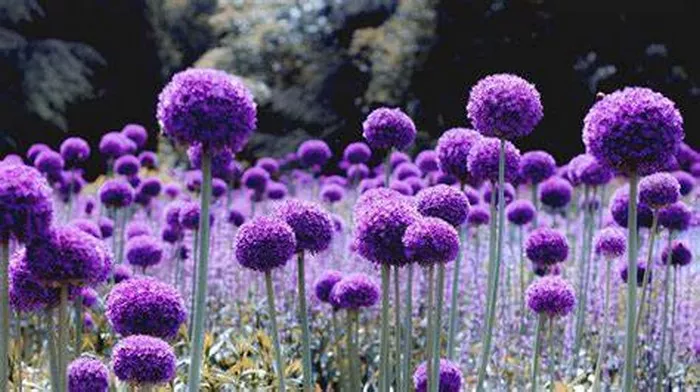Allium flowers, renowned for their ethereal allure and diverse forms, captivate gardeners and enthusiasts worldwide. From their intricate structures to their vibrant hues, Alliums add an enchanting charm to any landscape. In this comprehensive guide, we delve into the fascinating world of Allium flowers, exploring their distinctive characteristics, captivating varieties, and essential cultivation tips.
What are Allium Flowers?
Allium flowers belong to the genus Allium, which encompasses over 900 species, including onions, garlic, chives, and ornamental Alliums. These perennial plants are members of the Amaryllidaceae family and are native to various regions across the Northern Hemisphere, particularly Europe, Asia, and North America.
Physical Characteristics of Allium Flowers
Allium flowers showcase a remarkable diversity in their appearance, yet they share several defining characteristics:
1. Inflorescence: Allium flowers typically bloom in spherical clusters known as umbels. These umbels consist of numerous individual florets densely packed together, creating a stunning globe-like shape.
2. Petals: Each floret within the umbel typically comprises six tepals, which are petal-like structures. These tepals may vary in color, ranging from shades of white, pink, purple, blue, and yellow, depending on the species and cultivar.
3. Stems: The sturdy stems of Allium flowers vary in height, ranging from a few inches to several feet tall, depending on the species. These stems provide structural support for the umbels and contribute to the plant’s overall aesthetic appeal.
4. Foliage: Allium plants are characterized by long, slender leaves that emerge from the base of the plant. These foliage leaves are often linear or strap-shaped and may vary in color from green to bluish-green, adding textural contrast to the garden landscape.
Popular Varieties of Allium Flowers
The genus Allium encompasses a vast array of species and cultivars, each possessing its unique charm and characteristics. Some of the most popular varieties of Allium flowers include:
1. Allium giganteum: Renowned for its impressive size, Allium giganteum produces large, spherical flower heads that can reach diameters of up to 6-8 inches. These striking blooms feature dense clusters of violet-purple florets atop tall, sturdy stems, making them a standout feature in any garden.
2. Allium aflatunense: Also known as Purple Sensation, Allium aflatunense is prized for its rich purple flower heads that bloom in late spring to early summer. This cultivar boasts globe-shaped umbels composed of tightly packed florets, creating a bold visual impact when planted en masse.
3. Allium schoenoprasum: Commonly known as chives, Allium schoenoprasum is a culinary herb prized for its delicate, onion-flavored foliage and dainty pink to purple flowers. Chives are versatile plants that thrive in a variety of garden settings, from herb gardens to ornamental borders.
4. Allium christophii: Also referred to as Star of Persia, Allium christophii is celebrated for its otherworldly flower heads, which resemble exploding fireworks. Each flower head consists of dozens of star-shaped, metallic purple florets that radiate outward, creating a mesmerizing display.
5. Allium caeruleum: Known for its exquisite blue flowers, Allium caeruleum adds a touch of cool elegance to garden borders and rockeries. The nodding, bell-shaped blooms of this species feature delicate petals in shades of sky blue, complemented by slender, arching stems.
Cultivation Tips for Allium Flowers
While Allium flowers are relatively easy to grow and maintain, they thrive under specific growing conditions:
1. Sunlight: Most Allium species prefer full sun to thrive and bloom prolifically. Plant them in a location that receives at least 6-8 hours of direct sunlight daily for optimal growth and flowering.
2. Well-Drained Soil: Alliums prefer well-drained, moderately fertile soil to prevent waterlogged conditions, which can lead to root rot. Ensure that the soil is loose, crumbly, and rich in organic matter to promote healthy root development.
3. Planting Depth: When planting Allium bulbs, ensure they are buried at a depth that is approximately three times the diameter of the bulb. This allows for proper root establishment and helps protect the bulbs from temperature fluctuations.
4. Spacing: Space Allium bulbs or plants according to their mature size, ensuring adequate airflow and room for growth. Crowded plantings can lead to competition for nutrients and increased susceptibility to disease.
5. Watering: While Alliums are relatively drought-tolerant once established, consistent moisture is essential during their active growth phase. Water newly planted bulbs thoroughly and provide supplemental irrigation during dry spells to promote healthy growth and flowering.
6. Fertilization: Incorporate a balanced, slow-release fertilizer into the soil before planting to provide essential nutrients for robust growth and blooming. Avoid excessive nitrogen fertilization, as it can promote lush foliage growth at the expense of flower production.
7. Mulching: Apply a layer of organic mulch, such as shredded bark or compost, around Allium plants to conserve soil moisture, suppress weeds, and regulate soil temperature. Mulching also adds organic matter to the soil as it decomposes, enriching the growing environment.
8. Deadheading: Remove spent flower heads promptly to prevent the plant from expending energy on seed production. Deadheading encourages continuous blooming and maintains the aesthetic appeal of the plant throughout the growing season.
Conclusion
Allium flowers captivate gardeners and admirers with their unique beauty, diverse forms, and easy-to-grow nature. Whether adorning flower beds, borders, or containers, these enchanting blooms add a touch of elegance and sophistication to any garden landscape. By understanding their distinctive characteristics and following proper cultivation techniques, gardeners can enjoy the splendor of Allium flowers year after year, creating breathtaking displays that inspire and delight.


